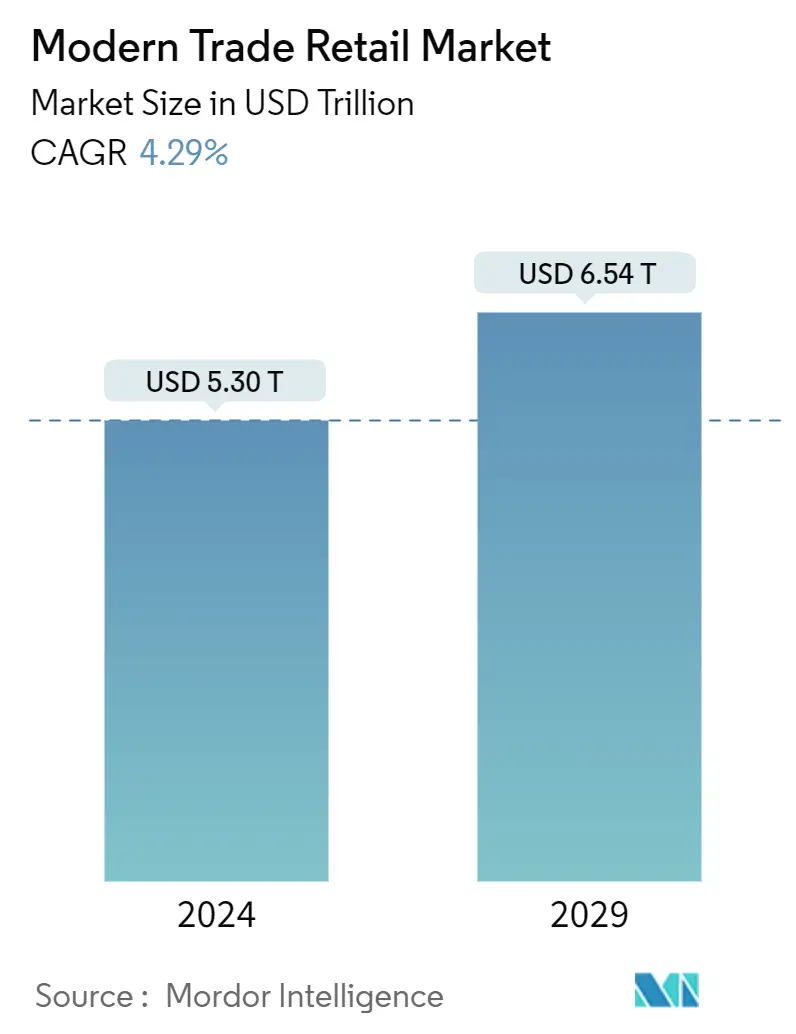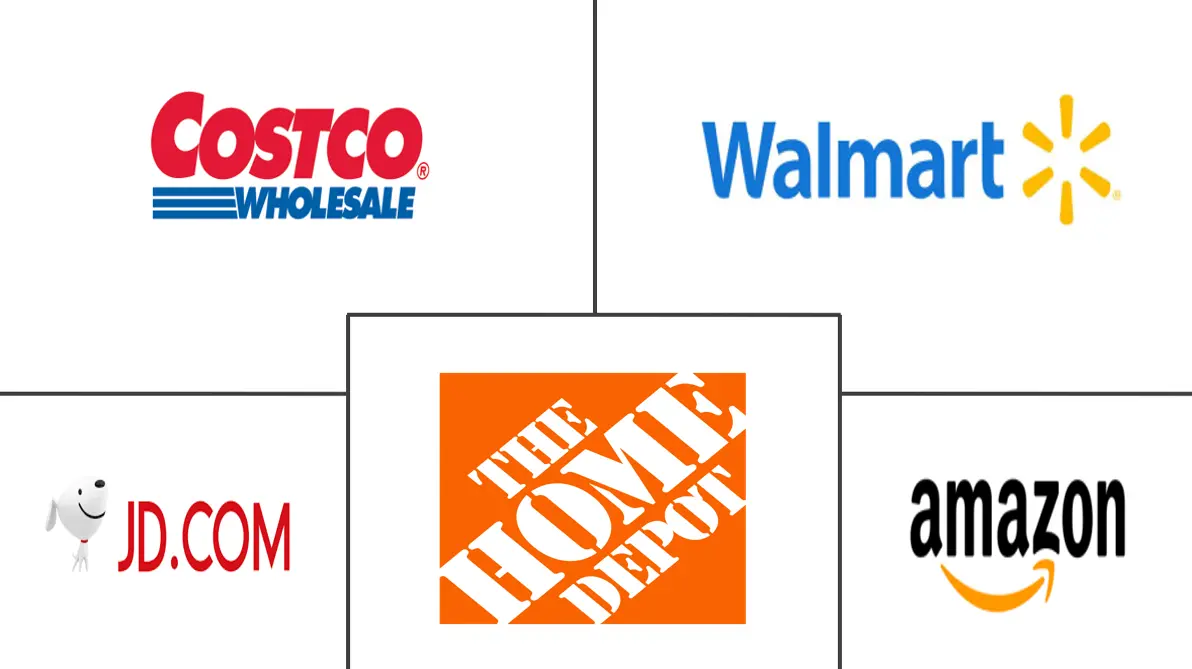Market Size of Modern Trade Retail Industry

| Study Period | 2020-2029 |
| Market Size (2024) | USD 5.30 Trillion |
| Market Size (2029) | USD 6.54 Trillion |
| CAGR (2024 - 2029) | 4.29 % |
| Fastest Growing Market | Europe |
| Largest Market | Asia Pacific |
Major Players
*Disclaimer: Major Players sorted in no particular order |
Modern Trade Retail Market Analysis
The Modern Trade Retail Market size is estimated at USD 5.30 trillion in 2024, and is expected to reach USD 6.54 trillion by 2029, growing at a CAGR of 4.29% during the forecast period (2024-2029).
The modern trade retail market has witnessed significant expansion, both in developed and emerging economies. Modern trade retail formats have gained popularity due to their ability to meet consumer demands effectively. Consumers appreciate the convenience, wide product selection, competitive pricing, and modern shopping experience offered by these establishments. The demand for quality products, reliable supply chains, and a one-stop shopping experience has further fueled the growth of modern trade retail.
The growth of modern trade retail has had an impact on traditional or informal retail outlets. While traditional retailers continue to serve specific niches and local communities, they face challenges in competing with the convenience, variety, and pricing offered by modern trade retail. However, a balance is maintained as both formats coexist to cater to diverse consumer needs. Several factors have contributed to the growth of the modern trade retail market. These include urbanization, rising disposable incomes, changing consumer lifestyles and preferences, increased awareness of branded products, and the convenience and variety offered by organized retail formats. The market is expected to continue evolving as retailers adapt to emerging trends and technologies to meet the ever-changing demands of consumers.
Modern Trade Retail Industry Segmentation
The modern trade retail market refers to the segment of the retail industry that includes supermarkets, hypermarkets, department stores, and other organized retail formats. The modern trade retail market is segmented by product type, ownership, distribution channel, and geography. By product type, the market is segmented into food, beverage, and grocery, personal and household care, apparel, footwear, and accessories, furniture and home décor, toys, hobby, and household appliances, and pharmaceuticals. By ownership, the market is segmented into retail chains and independent retailers. By distribution channel, the market is segmented into supermarkets/hypermarkets, specialty stores, online, and others (convenience stores and department stores). By geography, the market is segmented into North America, Europe, Asia Pacific, South America, and the Middle East and Africa. The report offers market size and forecasts for the modern trade retail market in value (USD) for all the above segments.
| By Product Type | |
| Food, Beverage, and Grocery | |
| Personal and Household Care | |
| Apparel, Footwear, and Accessories | |
| Furniture and Home Decor | |
| Toys, Hobby, and Household Appliances | |
| Pharmaceuticals |
| By Ownership | |
| Retail Chains | |
| Independent Retailers |
| By Distribution Channel | |
| Supermarkets/Hypermarkets | |
| Specialty Stores | |
| Online | |
| Other Distribution Channels |
| By Geography | |||||||||
| |||||||||
| |||||||||
| |||||||||
| |||||||||
|
Modern Trade Retail Market Size Summary
The modern trade retail market is experiencing substantial growth, driven by its ability to meet evolving consumer demands through convenience, extensive product offerings, and competitive pricing. This market expansion is evident in both developed and emerging economies, where modern trade formats are increasingly preferred over traditional retail outlets. The rise of urbanization, increased disposable incomes, and changing consumer lifestyles have further propelled the demand for organized retail formats. As modern trade continues to evolve, it is adapting to emerging trends and technologies, ensuring a one-stop shopping experience that caters to the diverse needs of consumers.
In the Asia-Pacific region, the modern retail trade market is witnessing significant demand growth, fueled by rising incomes, urbanization, and the expansion of e-commerce. The region's rapidly growing economies, such as China, India, and Southeast Asia, are contributing to the increased popularity of modern retail formats like supermarkets and hypermarkets. The integration of e-commerce with traditional retail has been a key driver, with companies like Flipkart and Amazon expanding their presence to meet consumer preferences for online shopping. The market remains fragmented, with major players like Walmart, Amazon, and JD.com leveraging technology and strategic partnerships to maintain a competitive edge.
Modern Trade Retail Market Size - Table of Contents
-
1. MARKET DYNAMICS AND INSIGHTS
-
1.1 Market Overview
-
1.2 Market Drivers
-
1.2.1 Rapid Expansion of Urban Areas
-
1.2.2 Rise of E-commerce and Omnichannel Retailing
-
-
1.3 Market Restraints
-
1.3.1 Intense Competition in the Market
-
1.3.2 Supply Chain Complexity
-
-
1.4 Market Opportunities
-
1.4.1 Increasing Focus on Innovative Retail Services
-
1.4.2 Harnessing Data Analytics for Customer Engagement
-
-
1.5 Value Chain Analysis
-
1.6 Industry Attractiveness: Porter's Five Forces Analysis
-
1.6.1 Threat of New Entrants
-
1.6.2 Bargaining Power of Buyers
-
1.6.3 Bargaining Power of Suppliers
-
1.6.4 Threat of Substitutes
-
1.6.5 Intensity of Competitive Rivalry
-
-
1.7 Insights into Technological Advancements in the Industry
-
1.8 Impact of COVID-19 on the Market
-
-
2. MARKET SEGMENTATION
-
2.1 By Product Type
-
2.1.1 Food, Beverage, and Grocery
-
2.1.2 Personal and Household Care
-
2.1.3 Apparel, Footwear, and Accessories
-
2.1.4 Furniture and Home Decor
-
2.1.5 Toys, Hobby, and Household Appliances
-
2.1.6 Pharmaceuticals
-
-
2.2 By Ownership
-
2.2.1 Retail Chains
-
2.2.2 Independent Retailers
-
-
2.3 By Distribution Channel
-
2.3.1 Supermarkets/Hypermarkets
-
2.3.2 Specialty Stores
-
2.3.3 Online
-
2.3.4 Other Distribution Channels
-
-
2.4 By Geography
-
2.4.1 North America
-
2.4.1.1 United States
-
2.4.1.2 Canada
-
2.4.1.3 Mexico
-
2.4.1.4 Rest of North America
-
-
2.4.2 Europe
-
2.4.2.1 United Kingdom
-
2.4.2.2 Germany
-
2.4.2.3 France
-
2.4.2.4 Russia
-
2.4.2.5 Italy
-
2.4.2.6 Spain
-
2.4.2.7 Rest of Europe
-
-
2.4.3 Asia-Pacific
-
2.4.3.1 India
-
2.4.3.2 China
-
2.4.3.3 Japan
-
2.4.3.4 Australia
-
2.4.3.5 Rest of Asia-Pacific
-
-
2.4.4 South America
-
2.4.4.1 Brazil
-
2.4.4.2 Argentina
-
2.4.4.3 Rest of South America
-
-
2.4.5 Middle East and Africa
-
2.4.5.1 United Arab Emirates
-
2.4.5.2 South Africa
-
2.4.5.3 Rest of Middle East and Africa
-
-
-
Modern Trade Retail Market Size FAQs
How big is the Modern Trade Retail Market?
The Modern Trade Retail Market size is expected to reach USD 5.30 trillion in 2024 and grow at a CAGR of 4.29% to reach USD 6.54 trillion by 2029.
What is the current Modern Trade Retail Market size?
In 2024, the Modern Trade Retail Market size is expected to reach USD 5.30 trillion.

